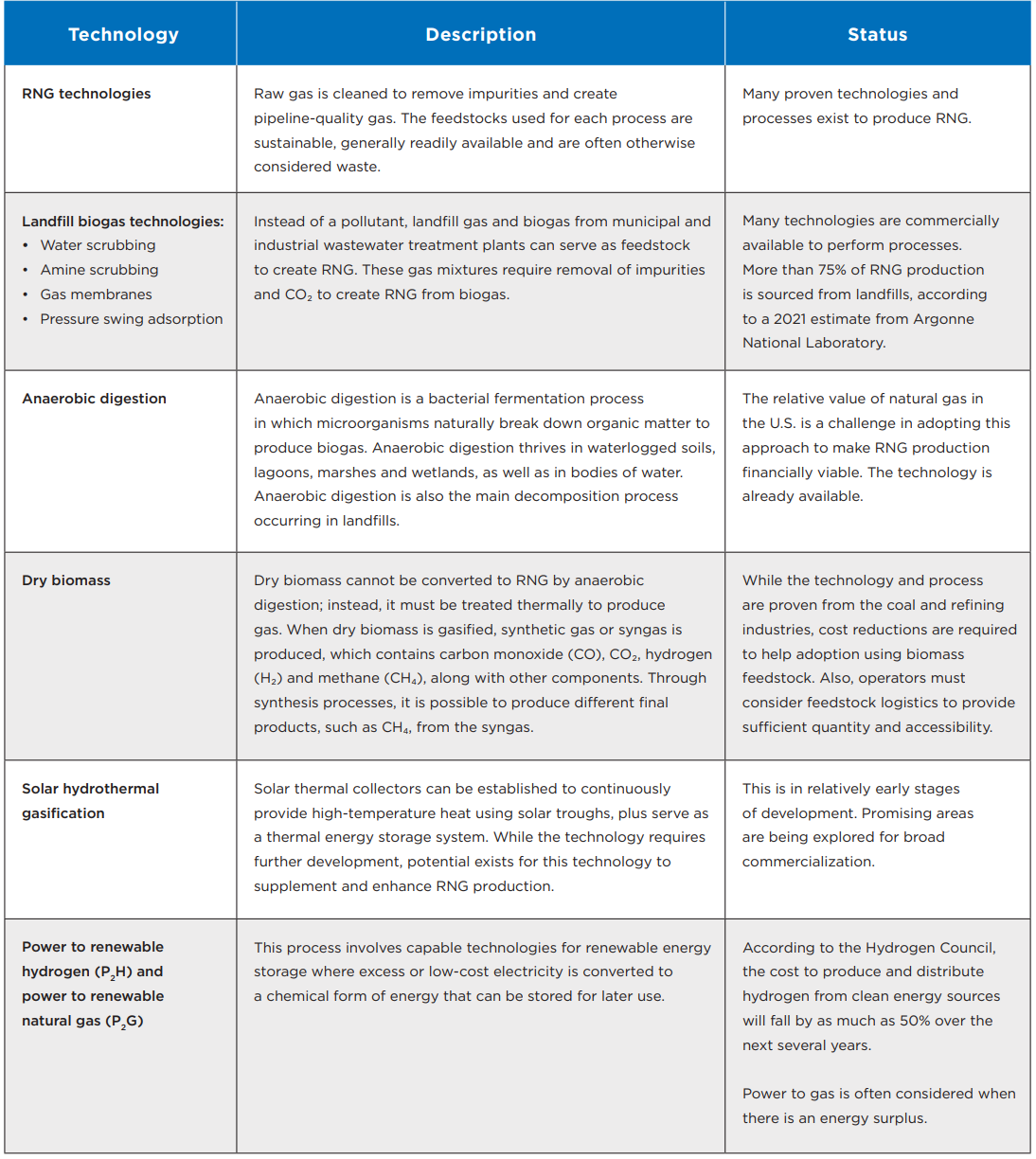EXPLORING THE BENEFITS OF RNG
There are potential benefits of leveraging RNG as a substitute for some fossil fuels. For that reason, several states, including California, Colorado, Nevada, New Hampshire, New Jersey, Oregon and Washington, have proposed legislation related to RNG. Much of the proposed legislation is focused on financial incentives for building new pipeline infrastructure and equipment.
The benefits of RNG take a variety of forms.
STORED AND TRANSPORTED THROUGH EXISTING NATURAL GAS PIPELINE NETWORKS
Unlike many renewable power generation sources, RNG can be stored by using existing field-proven processes and commercially ready technologies for later on-site usage or to transport it to other locations through pipelines.
The pipeline network offers storage and distribution for RNG. However, as these pipelines are usually owned by private or municipal gas utilities, the RNG developers must sign an agreement with the pipeline owner to supply RNG through the natural gas pipelines. The most important requirement of this agreement is to see that the RNG infused into the pipeline meets the local gas utility’s guidelines and criteria.
After the RNG is infused into the pipeline network, it can be used as a fuel for domestic as well as commercial and industrial purposes.
REDUCTION IN GREENHOUSE GAS EMISSIONS
RNG offers the same low-carbon properties of natural gas but produces 4% of the greenhouse gas emissions when burned. It qualifies as a renewable fuel under the federal Renewable Fuels Standard (RFS) and as a low-carbon fuel within California’s Low Carbon Fuel Standard (LCFS).
From a greenhouse gas emissions perspective, RNG demonstrates tremendous benefits. Methane from animal waste and other biomass sources, which otherwise would have directly entered the atmosphere, can be captured for conversion and combustion as RNG. The greenhouse gases released from that combustion are approximately 21 times less potent than methane released directly into the atmosphere. The use of RNG represents the recycling of carbon that is already circulating in the environment, whereas burning a fossil fuel represents the release of new carbon emissions that were previously sequestered in the earth.
RNG projects capture and recover methane produced at a landfill or agriculture facility. Why does this matter? Methane has an impact that is 25 times greater than carbon dioxide (CO2). Thus, by reducing methane emissions, environmental impacts can be significantly reduced.
INCREASED DOMESTIC ENERGY TO POWER COMMUNITIES
From running commercial and industrial facilities to cooking dinner at home, we depend on energy supplies. RNG provides security by increasing the domestic production of renewable non-fossil fuel energy that could supplement foreign-produced transportation fuels.
According to the EPA, RNG is also more cost-effective than some alternatives. For example, it is estimated to be three times more cost-effective than any electrification project.
Additionally, the EPA estimated there is enough growing supply of RNG in the U.S. to meet many states’ greenhouse gas emission goals by replacing a portion of other, higher-emission fossil fuels.
IMPROVED WASTE MANAGEMENT
According to the EPA, municipal solid waste landfills are the third-largest human-generated source of methane emissions in the U.S. With landfills generating a large amount of methane, opportunities abound to improve waste management practices. Many communities, residents and organizations are coming together to create partnerships to leverage landfill gas (LFG) to generate energy and reduce methane emissions.
It is estimated these LFG-to-energy facilities can capture nearly 60% to 90% of methane from landfills. Emissions into the environment are decreased and the methane is transformed into a viable electricity source. In 2020, a typical 3-megawatt LFG-to-energy plant is estimated to generate enough electricity to power approximately 1,900 homes.
REVENUE SOURCE FOR FARMERS
In 2017, California adopted legislation that will require reducing methane emissions by 40% by 2030. As a result, the state has provided many incentives for creating and using RNG. The California Department of Food and Agriculture created the Dairy Digester Research and Development Program, which awards competitive grants to implement projects that result in methane emission reductions and minimize environmental impacts.
For example, biogas produced at existing facilities is actively being injected as RNG into pipelines. At the facilities, cow manure is collected from local dairy farms and processed into an anaerobic digester to accelerate the natural decomposition process. Methane is captured and converted to make renewable fuels for vehicles.
When one such dairy farm was completed in 2019, it was believed to be the largest dairy biogas operation in the U.S. In 2020, the operation was expanded to add four dairy farms, doubling the amount of RNG produced.
GREEN JOBS CREATION
Green jobs can be defined as opportunities in the fields of energy and agriculture that aim to significantly safeguard and restore environmental quality.
The energy from waste aids in creating thousands of jobs, such as for renewable energy engineers, recycling workers, environmental consultants and more. According to the RNG Coalition, by 2030 there are expected to be 24 million jobs in the global renewable energy sector. Also, each new RNG production facility has the potential to create five to seven times more jobs than an equivalent-sized petroleum refinery.
.png?width=175&name=azco-white-logo-2020%20(1).png)
